Ethics and Responsible Disclosure
Layout
-
Computer Laws
-
Cyber-ethical dilemmas
-
Responsible disclosure
Computer Laws
Israel’s computer laws1 are case-laws – meaning there are a few written laws, and a judge would use those along with precedents and personal judgment to determine whether a person is guilty. This is opposed to continental-law, in which everything is written and proceedings are executed literally by the book.
Definitions
-
“computer material” - software or computer information
-
“computer” - A device that works with a software to perform arithmetic or logical processing of data and peripherals, with exception to auxiliary computer
-
“auxiliary computer” - A device that is only able to perform arithmetic processing
-
“information” - or computer information, is signs, instructions, data or concepts, except for software. the information is expressed via computer language and stored in the computer or any other media or volume.
-
“output” - any information that is produced or derived via the computer
-
“computer language” - appropriate expressive form for interpretation, delivery or processing by computer
-
“software” - A group of instructions expressed in the computer language that can cause a computer to function or to perform an action, and is either embedded or marked with a device or by means of electronic, electromagnetic, electro-optics or any other means, or either united with the computer in some way or separated from it
The laws state which cyber-activities are considered illegal, as follows:
-
Unlawfully disrupting or interfering with a computer system
-
Unlawfully modifying or deleting any material or files from the computer system
-
Providing false information or false output
-
Unlawful access, invade or penetrate to a computer system
-
Unlawful eavesdrop, according to the Wiretap Act 1979 rule
-
As the above, but in order to commit another offence
-
Creating, distributing or offering to another person a computer virus (a virus can perform variety of malicious actions, such as removing/changing files, ransomware, backdoor, etc.)
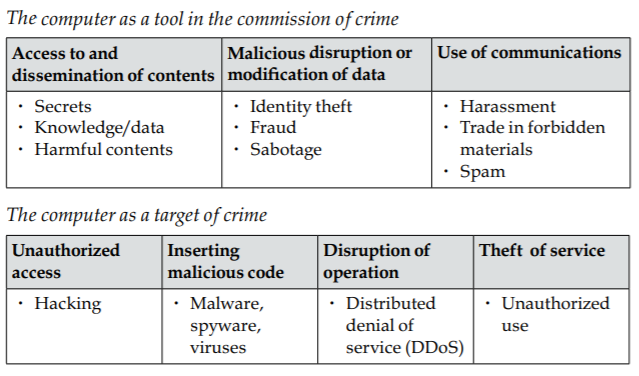
From this we learn that not any crime committed with the aid of a computer constitutes a cyber-crime; if a computer was used in the process of the crime, but none of the above computer laws were broken – for example while profiteering2 off an online ticket sale – the action, while illegal, is not a cyber crime.
Unlawful Disruption or Interfering with a Computer System
Definition.
Disrupting the normal operation of a computer, interfering with the use of a computer or deleting of materials saved on a computer.
Let’s observe some examples:
-
Performing a DDoS attack on a server
-
Infecting a computer with a virus preventing access to information saved on it
-
Recruiting a computer into a botnet, thus draining its resources
-
Infecting a computer with a program that sends information from it to a remote server
-
Cheating at a single player video game
-
Installing an unlicensed program
All of the above actions are illegal. The first three are violations of the first section of Israel’s computer laws, while the latter three are illegal for other reasons, since they do not directly prevent/interfere with the victim’s system’s functions.
False Information or Output
Definition.
Misinformation; generating, or changing the code of a program such that it would generate information that is forged or misleading. Let’s observe some examples:
-
Sending an email on behalf of someone else without their consent
-
Changing the code of a grade-calculating program in order to change the output grades
-
Cheating in an online game to gain an unfair advantage
-
Using a key generator: a program that forges fake software licenses
-
Recruiting a computer into a botnet
-
Accessing an email inbox of another user
All of the above actions are illegal, but only the first four violate the second section of Israel’s computer laws.
Unlawful Access
Definition.
Virtual trespassing; any action which results in the perpetrator accessing information to which they do not have access, such as images, text files, code, etc.
Let’s observe some examples:
-
Viewing personal information of coffee shop patrons by using the same Wi-Fi
-
Penetration testing (attempting to find weaknesses) on a company’s server without its consent
-
Using some else’s password to access their inbox without their consent
-
Using a program to forge credit card numbers
Forging credit card numbers, while illegal, does not fall under this section of the law; it is constitutes as false information. Note that penetration testing is a violation of this section of the law even if it is unsuccessful.
Cyber Ethics
We first present two case studies, then proceed to discuss them and cyber ethics in general.
Case Studies
Stresser.
Two people from Israel ran a DDoS service, known as Stresser, which performed DDoS attacks on websites for money. They made a large profit, but were eventually caught, and claimed they were ethical, and there are occasions where they refused to attack Israeli websites. What were their motives?
Eternal Blue.
In 2013, the NSA found a vulnerability in Windows and secretly built a tool called Eternal Blue to exploit it. At some point, a group of hackers known as the Shadow Brokers stole security tools from the NSA and offered to sell them on the Dark Net. When nobody paid, the Shadow Brokers leaked the tools. Microsoft released a patch to fix the bug a short time later; the patch was prepared in advance after Microsoft was tipped off by the NSA.
In 2017, a piece of malware known as “WannaCry” first appeared; it utilized Eternal Blue to spread quickly through computers on which the security patch wasn’t yet installed, and encrypt the victim’s files, then asking for money to decrypt them3.
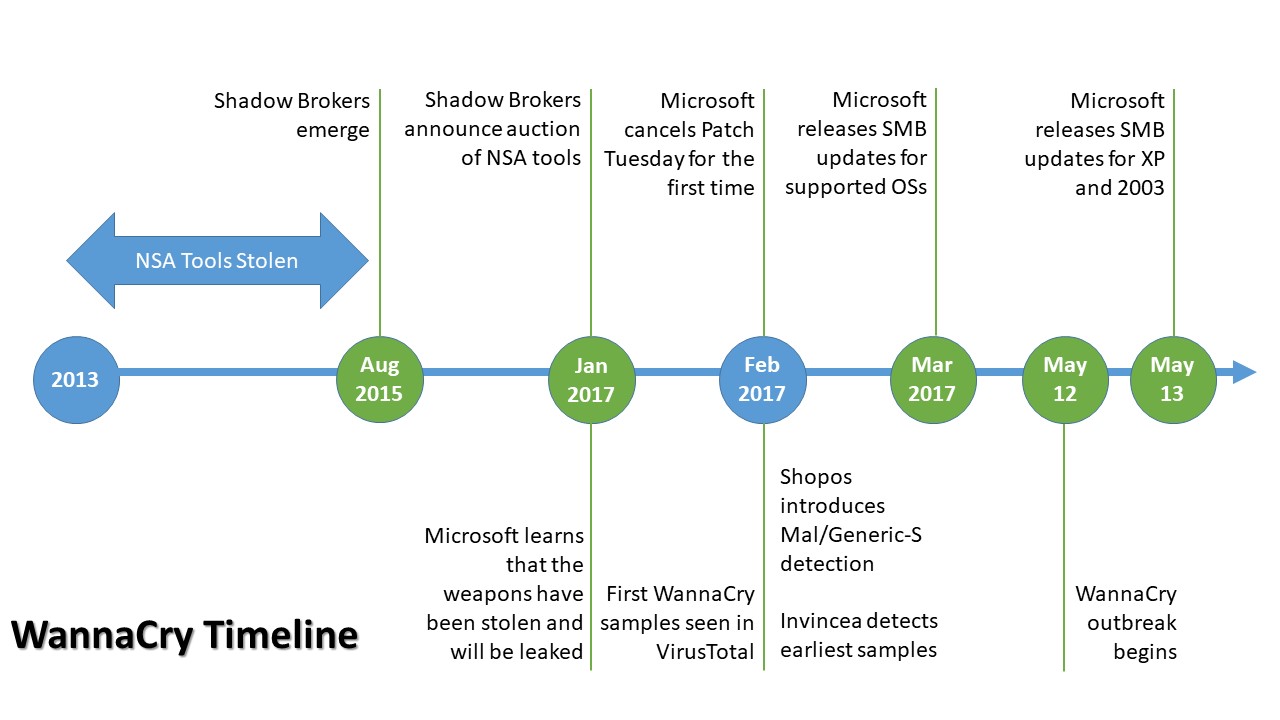
WannaCry was finally beaten when a malware researcher found it made requests to an unused control domain, and purchased the domain.4 As it turned out, purchasing the domain triggered the destruction of WannaCry, whether by mistake or by design (the domain could have been designed as a kill-switch).
While WannaCry did not make a lot of money, it had a nasty side-effect on healthcare systems; medical equipment that got infected could not function normally, with dangerous, possibly lethal, repercussions.
Suppose a man was killed due to a failure induced by WannaCry; let John be such a casualty. There are many parties in this story, each holding part of the blame for John’s death:
-
WannaCry’s writers, whose malware caused John’s death
-
Microsoft, whose software was used and trusted by the hospital
-
The hospital, which relied solely on Microsoft’s software without providing safety measures of their own
-
The NSA, who knew about the bug well in advance, but did not perform responsible disclosure
-
The Shadow Brokers, who leaked the NSA’s tools to the public, which lead to the development of WannaCry
Discussion
Ethics.
Ethical behavior is deciding how to act according to one’s moral system. It is mostly instinctive, or composed of a personally devised code, rather than conforming to a set of rigid universal rules.
The Trolley Problem.
Imagine a trolley approaching a fork in the railway. On the first path lie five people, and on the second only a single person. The trolley, if its course remains unchanged, will head for the first path, resulting in the deaths of the five people there. However, you as a bystander have the option to pull a lever to change the direction of the trolley to the second path, resulting in the single death of the man there.

According to the numbers, you should pull the switch to save the five. But in that case, by sending the trolley toward the single person on the other path, you are directly responsible for his death! So should you avoid getting involved, thus allowing the deaths of five people instead?
What if one of the people is a close friend? Would that change your answer?
There is another version to this problem, in which there is only a single road with five people on it. You, along with a very large man, are standing on a bridge above the road, and you have the option of pushing the large man beside you off the bridge to block the approaching trolley. The stakes are the same, but in the scenario, in order to save the five you need to actually commit murder!

Our “closeness” to a situation affects on how we judge it by our moral standards.
How to decide.
There are two main theories by which the morality of an action is judged:
-
Deontological ethics (Kant5) – what do my rules/morals say about this action? (i.e. judge by motives)
-
Utilitarian ethics (Bentham6) – what are the consequences of this action? (i.e. judge by consequences)
Consider the cyber setting. If we were to program ethics into an AI (say, an autonomous car), we would have to use Utilitarian Ethics – a score system by which the algorithm could judge what would be the least terrible outcome according to our moral system.
This presents complications; for example, let’s consider a practical implementation of the Trolley Problem in autonomous cars: Assume a car is driving on a bridge containing five pedestrians in the middle of the road. If the car continues on its path, they will all die. However, the car can choose to veer off the bridge, saving five lives but killing the driver. By utilitarian considerations, this is the best approach – but who will purchase a car which is programmed to kill him on certain circumstances?
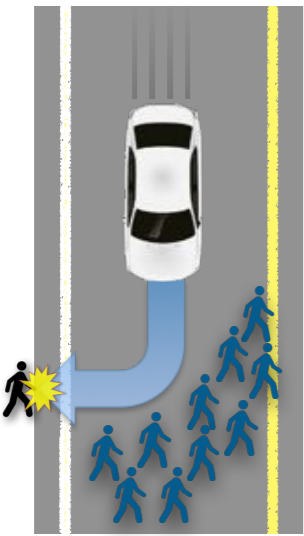
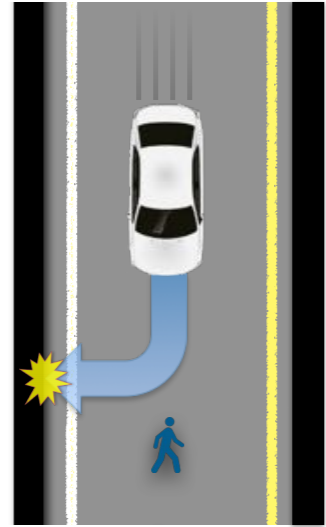
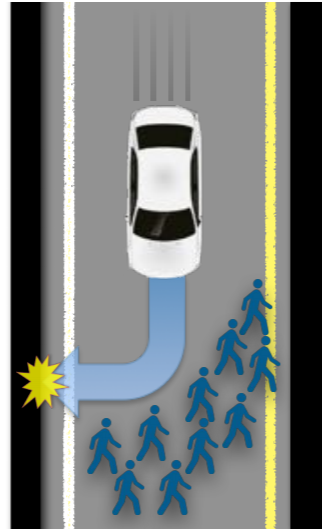
Cyber crime.
Our brain is “programmed” to feel distressed when confronted with an unethical scene; i.e. when we see a scene of a person committing an unethical act, we feel bad in sympathy with the victim. This is why it is easier to commit a cyber crime – we do not see the victim, and do not sympathize with them. Upholding cyber ethics would mean artificially causing users to use their judgment when their brains would not.
Responsible Disclosure
Disclosure is the act of alerting a product vendor to a vulnerability in their product so that they could patch it. Disclosure is performed by an honest party (i.e. not a hacker who wishes to exploit the vulnerability) with the intention of increasing the security of the product. There is a question of exactly when and how to perform this disclosure.
An exploit is considered as zero day when the vendor is unaware of the vulnerability it exploits (meaning it is known only to a few, and unknown to the general public - i.e. it has not been disclosed).
describes a timeline of a vulnerability from the moment it is found to the moment its patch is deployed.
Symantec, the company founding Nortron7, had a lot of data regarding vulnerabilities and exploits, and used it to research the matter. shows their results.
From Symantec’s results, we conclude the following:
-
Zero days exist
-
Usually zero days are targeted, and not highly used so that they would remain secret.
-
Disclosure is terrible for security; after a patch is released, attackers use it to find the vulnerabilities and exploit them. Attackers go through public responsible disclosure and attack even before a patch is released. Between the point where the disclosure was made publicly and the patch deployment was completed, the scale of attacks rose by 5 orders of magnitude, making public disclosure a bad idea.
Responsible disclosure.
There is a government operated website called CVE – Common Vulnerabilities and Exposures. Disclosure could be performed by uploading a vulnerability to the site such that only the owner of the software can see it, and publish the details only when a patch is released (between points tp and ta in 1.8), to avoid the window when the vulnerability is public and unpatched (between t0 and tp in 1.8). Microsoft called this practice of disclosing privately Coordinated Vulnerability Disclosure, and claim it significantly reduces the amount of exploits on new vulnerabilities.
Google introduced a system where the vulnerability remains private for 90 days, after which it goes public, with or without a patch. The strict deadline is meant to make sure the vulnerable vendor does not dismiss fixing the bug due to it being unknown, and thus security is improved.

Over the years using machine learning with CVEs was used for detecting and classifing vulnerabilities in code, as well as making automatic predictions for unseen vulnerabilities.
On the other hand, CVEs can be used to find unpatched exploits – for example, there was a bug in Linux which hasn’t yet gone public, but someone needed to commit the changes, which contained the CVE-ID. Thus hackers could see the fix and exploit the vulnerability before a patch was posted.
-
Published in Sefer Hachukkim 5755 No. 1534, 25 July 1995 p. 366 (P.L. 5754 No. 2278 p. 478). ↩
-
The activity of taking unfair advantage of a situation to make a large profit, often by selling goods that are difficult to get at a very high price (Cambridge Business English Dictionary). ↩
-
This is known as ransomware. Recall that this falls under the first section of the computer laws. ↩
-
Malware researchers often try to purchase control domains in order to gain information on the behavior of the malware. ↩
-
Immanuel Kant was a German philosopher during the Enlightenment era. His contributions have had a profound impact on almost every philosophical movement that followed him. ↩
-
Jeremy Bentham was an English philosopherduring the Enlightenment era and a social reformer regarded as the founder of modern utilitarianism. ↩
-
Norton is an anti-virus. ↩